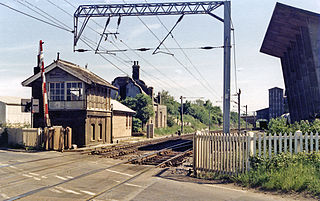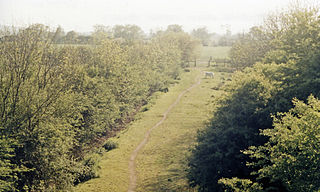Related Research Articles

The Portishead Railway is a branch line railway running from Portishead in North Somerset to the main line immediately west of Bristol, England. It was constructed by the Bristol & Portishead Pier and Railway Company, but it was always operated by its main line neighbour, and was more usually thought of as the Portishead branch or the Portishead railway.
The Lanarkshire and Ayrshire Railway (L&AR) was an independent railway company built to provide the Caledonian Railway with a shorter route for mineral traffic from the coalfields of Lanarkshire to Ardrossan Harbour, in Scotland.

Claydon railway station was a station in Great Blakenham, Suffolk. It closed to passengers in 1963. The goods facility for Blue Circle Cement, British Steel Piling and Kings Scrapyard was still staffed in the late 1970s with the staff working from the former up side station buildings.
The Oxford, Witney and Fairford Railway was a single track railway branch line, 22 miles (35 km) long, in Oxfordshire and Gloucestershire in England in the United Kingdom. It was opened in succession by two companies, the first in 1861 to connect the important wool-producing town of Witney to the main line network, and the second in 1873 as the rump of an ambitious scheme to connect to Cheltenham, but which ran only between Witney and Fairford. The junction with the main line was at Yarnton, north of Oxford.

Thornhill is a closed station. It served the country town of Thornhill in Dumfries and Galloway. The station site is a mile or so from the town. Four miles north of Thornhill is Drumlanrig Castle, home to the Duke of Buccleuch and Queensberry. The Glasgow and South Western main line rail route between Kilmarnock and Dumfries is forced to make a long detour to the east of Thornhill and through a long tunnel, rather than the more logical route nearer Thornhill town centre and up the Nith Valley, so as not to be seen from the Buccleuch estate. The distance of the station from Thornhill may be one reason that passenger use was light and stopping services ended in 1965. There was formerly a busy livestock market near to the station, which eventually closed around 2001.

Cassington Halt was a single platform halt opened by the Great Western Railway on 9 March 1936 on the Oxford, Witney and Fairford Railway to serve the village of Cassington, Oxfordshire, just south of the A40.

Eynsham railway station served the Oxfordshire town of Eynsham and the Eynsham Sugar Beet Factory on the Oxford, Witney and Fairford Railway between Oxford and Witney.

Carterton railway station was a railway station just north of the village of Black Bourton on the Oxford, Witney and Fairford Railway between Oxford and Fairford. The station had two stone-built platforms, a passing loop, and a concrete station building.
References
- Wignall, C J (1985). Complete British Railway Maps and Gazetteer (1825–1985). Poole, UK: Oxford Publishing Company. ISBN 0-86093-294-X.
- "Disused Stations" . Retrieved 13 June 2008.